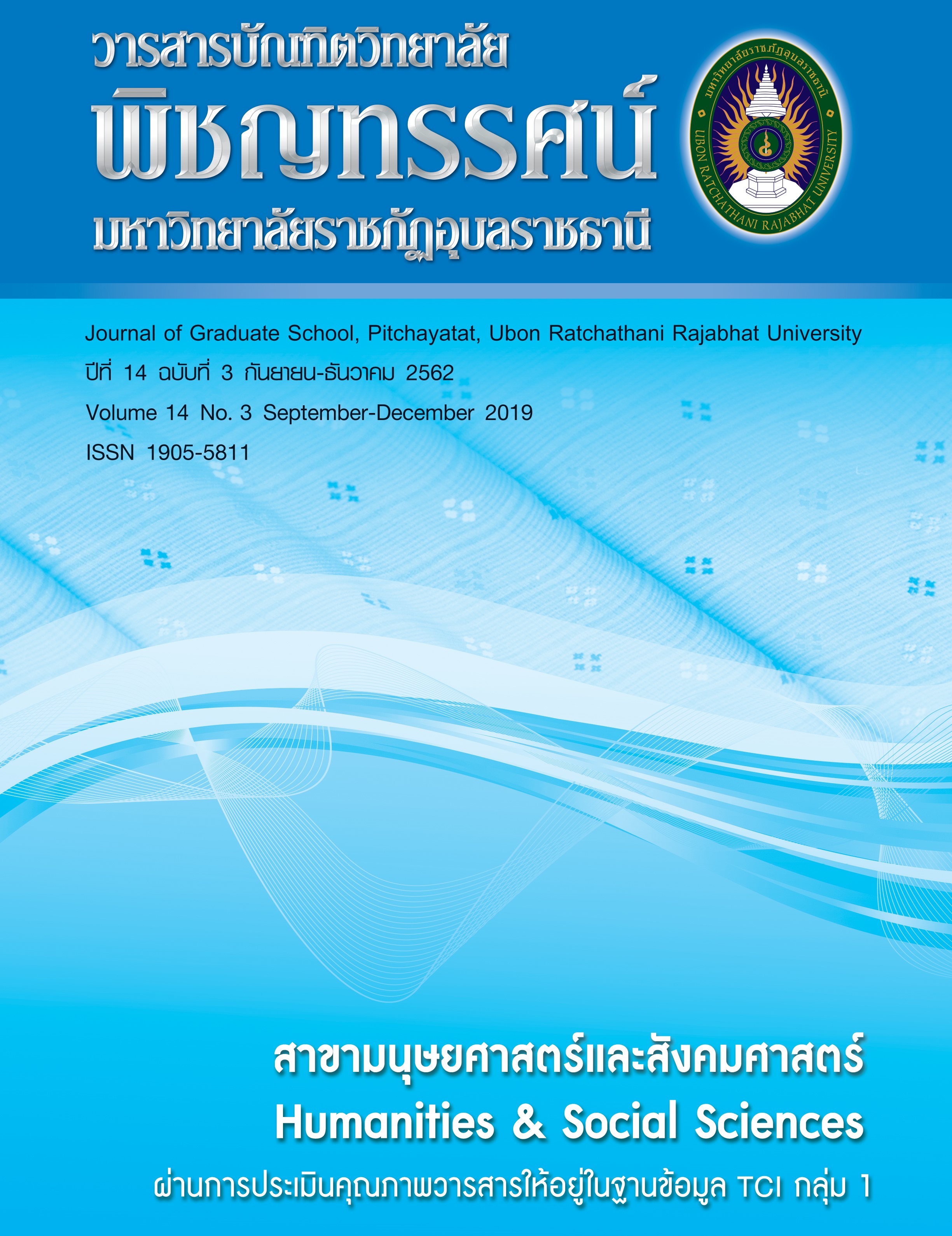รูปแบบพัฒนาพฤติกรรมเชิงจริยธรรมของนักศึกษามหาวิทยาลัยราชภัฏในเขตภาคตะวันออกเฉียงเหนือ
คำสำคัญ:
รูปแบบพัฒนา, พฤติกรรมเชิงจริยธรรมบทคัดย่อ
การวิจัยนี้มีวัตถุประสงค์ 1) เพื่อค้นหากรอบแนวคิดทฤษฎีพฤติกรรมเชิงจริยธรรม โดยการสัมภาษณ์ผู้ทรงคุณวุฒิ จำนวน 6 คน 2) เพื่อตรวจสอบโมเดลสมการโครงสร้างพฤติกรรมเชิงจริยธรรมกับข้อมูลเชิงประจักษ์ ตัวอย่าง จำนวน 400 คน ได้มาโดยการสุ่มอย่างง่าย 3) เพื่อสร้างรูปแบบพัฒนาพฤติกรรมเชิงจริยธรรมของนักศึกษา จากกลุ่มเป้าหมายตัวแทนนักศึกษาจำนวน 20 คน โดยเลือกแบบเฉพาะเจาะจง 4) เพื่อทดลองและประเมินรูปแบบพัฒนาพฤติกรรมเชิงจริยธรรมของนักศึกษา โดยกลุ่มเป้าหมายคือ ตัวแทนนักศึกษา จำนวน 150 คน โดยเลือกแบบเฉพาะเจาะจง
ผลการวิจัยพบว่า 1) กรอบแนวคิดทฤษฎีพฤติกรรมเชิงจริยธรรมทั้งหมด 5 มิติ ประกอบด้วย 1. ความเข้าใจ 2. ทัศนคติ 3. วิจารณญาณ 4. พฤติกรรม 5. บุคลิกภาพ
2) ผลการวิเคราะห์องค์ประกอบเชิงยืนยันของโมเดลความสัมพันธ์สมการโครงสร้างพฤติกรรมเชิงจริยธรรมกับข้อมูลเชิงประจักษ์ของนักศึกษา มีค่าความเชื่อมั่นเชิงโครงสร้าง = 0.998 และมีความเที่ยงตรงเชิงโครงสร้างเป็นไปตามเกณฑ์ที่กำหนด คือ χ 2 = 124.465, df = 94, P-value = 0.225, CFI = 0.721, TLI = 0.643, SRMR = 0.063, RMSEA = 0.019, χ 2 /df = 1.302<2
3) การสร้างรูปแบบการพัฒนาพฤติกรรมเชิงจริยธรรมของนักศึกษามหาวิทยาลัยราชภัฏในเขตภาคตะวันออกเฉียงเหนือ ได้รูปแบบการพัฒนาพฤติกรรมเชิงจริยธรรมในมิติสถาบันการศึกษา ด้านกิจกรรมเชิงจริยธรรม จำนวน 2 กิจกรรม ได้แก่ (1) กิจกรรมพัฒนาจริยธรรมด้านกัลยาณมิตรด้วยการหยุดคิดสะกิดเพื่อน (2) กิจกรรมเชิงจริยธรรมด้วยการควบคุมฝึกตนปฏิบัติตามกฎระเบียบของสังคม และด้านการบูรณาการจริยธรรมในหลักสูตร จำนวน 2 กิจกรรม ได้แก่ (1) กิจกรรมการพัฒนาจริยธรรมและค่านิยมที่พึงประสงค์ตามหลักสูตร (2) กิจกรรมพัฒนาคุณธรรมจริยธรรมและบุคลิกภาพ
4) ผลการทดลองรูปแบบพัฒนาพฤติกรรมเชิงจริยธรรมด้านความรู้ ด้านทัศนคติ ด้านวิจารณญาณ ด้านพฤติกรรม และด้านบุคลิกภาพ นักศึกษามีการพัฒนาพฺฤติกรรมเชิงจริยธรรมที่ดีขึ้นอย่างมีนัยสำคัญทางสถิติที่ระดับ .05
เอกสารอ้างอิง
ฐานปนีย์ พสิษฐ์เนาวกุล และพรสวรรค์ สุวัณณศรีย์. รายงานการวิจัยการศึกษารูปแบบการพัฒนาคุณธรรมจริยธรรมนักศึกษามหาวิทยาลัยราชภัฏเลย. เลย: มหาวิทยาลัยราชภัฏเลย, 2555.
ดวงสุดา พินนอก และสุพรรณ บุญมา. รายงานการวิจัยการศึกษาพฤติกรรมเชิงจริยธรรมของนักศึกษาสาขาการศึกษาชั้นปีที่ 1 มหาวิทยาลัยราชภัฏนครราชสีมา. นครราชสีมา: มหาวิทยาลัยราชภัฏนครราชสีมา, 2548.
พูลพงษ์ สุขสว่าง. หลักการวิเคราะห์โมเดลสมการโครงสร้าง. วารสารมหาวิทยาลัยนราธิวาสราชนครินทร์. 6, 2 (พฤษภาคม-สิงหาคม 2559): 136-145.
วราลี โกศัย และคณะ. รายงานการวิจัยการสำรวจคุณธรรมจริยธรรมของนักศึกษาสาขาการศึกษาปฐมวัย. บุรีรัมย์: มหาวิยาลัยราชภัฏบุรีรัมย์, 2551.
สุภาพ ณ นคร และคณะ. รายงานการวิจัยการศึกษาวิเคราะห์รูปแบบที่เหมาะสมในการพัฒนาบัณฑิตอุดมคติไทยมหาวิทยาลัยขอนแก่น. ขอนแก่น:สำนักมาตรฐานและประเมินผลอุดมศึกษา, 2547.
สุวิมล ว่องวาณิชและนงลักษณ์ วิรัชชัย. รายงานการวิจัยเรื่องปัจจัยและกระบวนการที่เอื้อต่อการพัฒนาคุณธรรมระดับบุคคลเพื่อมุ่งความสำเร็จของส่วนรวมของนักศึกษามหาวิทยาลัย: การศึกษาเชิงปริมาณและคุณภาพ. กรุงเทพฯ: จุฬาลงกรณ์มหาวิทยาลัย, 2543.
สุวิมล ว่องวาณิชและคณะ. รายงานการวิจัยโครงการเร่งสร้างคุณลักษณะที่ดีของเยาวชนไทย. กรงเทพฯ: ศูนย์ส่งเสริมและพัฒนาแผ่นิดินเชิงคุณธรรม (ศูนย์คุณธรรม) และสำนักงานบริหารและพัฒนาองค์ความรู้ (องค์การมหาชน), 2549.
สุนทรพจน์ ดำรงค์พานิช. โมเดลการจัดลำดับความสัมพันธ์เชิงสาเหตุของอัตมโนทัศน์ วิชาการอัตมโนทัศน์ไม่ใช่วิชาการ และผลสัมฤทธิ์ทางการเรียน: การวิเคราะห์กลุ่มพหุ. วิทยานิพนธ์ครุศาสตรดุษฎีบัณฑิตจุฬาลงกรณ์มหาวิทยาลัย, 2550.
สำนักงานคณะกรรมการการอุดมศึกษา. จดหมายข่าวรายสัปดาห์. 3, 105 (มีนาคม 2559): 5.
ศักดา ปรางค์ประทานพร. ปรัชญาการศึกษาขั้นพื้นฐาน.ชลบุรี: มหาวิทยาลัยศรีครินทรวิโรฒ, 2526.
อภิญญา มานะโรจน์. การศึกษากระบวนการปลูกฝังคุณธรรมแก่นิสิตจุฬาลงกรณ์มหาวิทยาลัย. วิทยานิพนธ์ปริญญาครุศาสตรมหาบัณฑิตจุฬาลงกรณ์มหาวิทยาลัย, 2539.
Barbara, M.B. Structural equation modeling with Mplus: basic concepts, application, and programming. New York: Taylor & Francis Group, 2012.
ดาวน์โหลด
เผยแพร่แล้ว
รูปแบบการอ้างอิง
ฉบับ
ประเภทบทความ
สัญญาอนุญาต
บทความทุกเรื่องได้รับการตรวจความถูกต้องทางวิชาการโดยผู้ทรงคุณวุฒิภายนอกอย่างน้อย 2 คน ความคิดเห็นในวารสารบัณฑิตวิทยาลัย พิชญทรรศน์ มหาวิทยาลัยราชภัฏอุบลราชธานี เป็นความคิดเห็นของผู้เขียนมิใช่ความคิดเห็นของผู้จัดทำ จึงมิใช่ ความรับผิดชอบของบัณฑิตวิทยาลัย มหาวิทยาลัยราชภัฏอุบลราชธานี และบทความในวารสารบัณฑิตวิทยาลัย พิชญทรรศน์ มหาวิทยาลัยราชภัฏอุบลราชธานี สงวนสิทธิ์ตามกฎหมายไทย การจะนำไปเผยแพร่ต้องได้รับอนุญาตเป็นลายลักษณ์อักษรจากกองบรรณาธิการ






